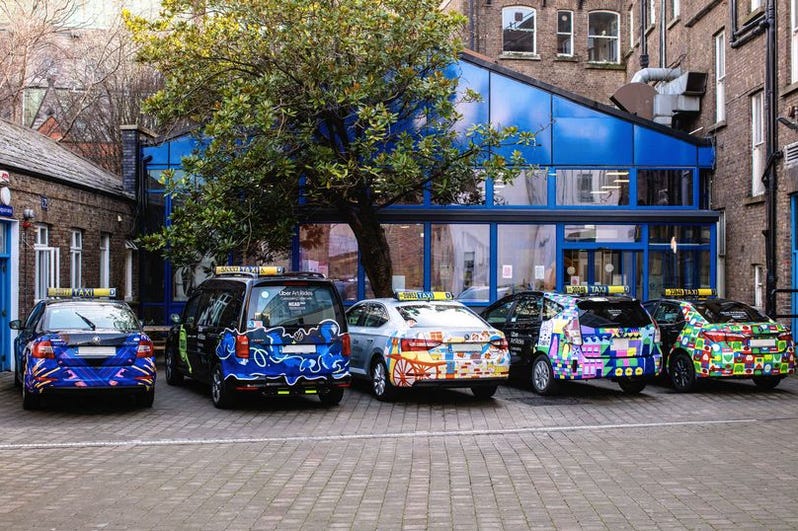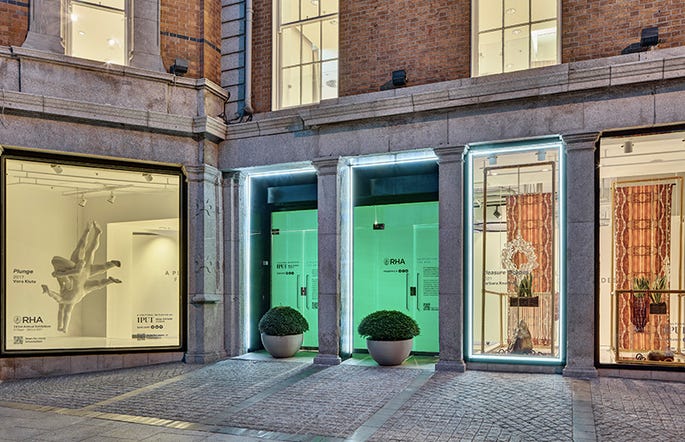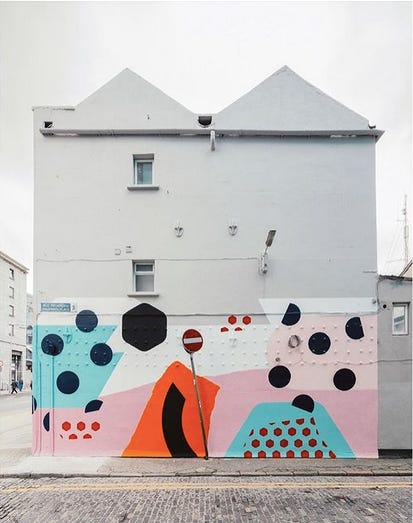First Glance
IPUT, the Irish Property Unit Trust, is the largest owner of office space in Dublin and one of the wealthiest real estate developers in the nation. Walking around the south side of the city where I live, you see the name everywhere on new high-rise office buildings and construction sites for future offices. Dublin is suffering from a housing crisis, rents are impossibly high, and taking out a mortgage is just a fantasy for all but the wealthiest of buyers, so building more luxury office space as people find comfort in working from home is a poor choice. But this hasn’t put IPUT off or caused them to slink into the shadows of other nameless landlords. Instead the company declares their presence in Dublin in the loudest way possible: by wrapping these luxury developments in a decorative veil of visual arts.
Double Take
Walking along the Grand Canal, just past the statue of poet and fellow canal-walker Patrick Kavanagh, you run into a curious urban assemblage known as Wilton Park. A small coffee cart is parked in the small triangular park, bordered on two sides by construction fencing emblazoned with IPUT’s slogan “Shaping Our City.” The park itself is owned and operated by the real estate company and contractors busy themselves around a shiny building on the park’s south side, the first of four new office buildings which is nearing completion. The most arresting part of the complex is the Living Canvas, €1m curved LED screen fixed to the construction fencing that displays a pulsing red animation. Wilton Park’s Living Canvas and its twin on IPUT’s quayside “Tropical Fruit Warehouse” development are what the company calls “placemaking,” using its real estate holdings as urban gallery spaces while they’re unoccupied.

This is seen as a charitable move by the company. The Irish Times describes the Living Canvas as “supporting the work of 16 Irish and international artists” by putting them on this screen for people to glance at as they drive or walk past. Uber, which operates as a taxi company in Dublin, held a competition for undergraduate art students to design prints for some of its cars, using their art to increase its visibility in the city. This placemaking supposedly benefits Dublin’s urban fabric as well. IPUT partnered with the Royal Hibernian Academy to display sculptural art in the windows of the former Topshop location on St. Stephen’s Green, adding color and culture to otherwise vacant (but not derelict) storefronts. But I don’t see real estate placemaking as meaningfully benefiting anyone but the real estate company.


Take for example the recent exhibition by Barbara Knežević, Deep Time Empaths, which was displayed in the unoccupied storefront on Chatham Street. The exhibition is a partnership between Temple Bar Gallery + Studios and Hines, the real estate company that owns the building. The sculptures of Deep Time Empaths sprawl through the space and attach to its support beams, they mimic the raw construction material of an unoccupied building but draped in snakeskin and glazed green look to be almost organic, alive. But unlike a gallery show, you can’t walk around the sculptures or interact with them in the way the exhibition wants. You just stare at them through the shop window. Viewed through the window the piece loses its organic nature, its narrative effort, becoming instead a showpiece, reminding you that the space, not the art, is the object for sale. Temple Bar Gallery gets some exposure and Barbara hopefully gets paid, but the true beneficiary is Hines.

Hindsight
One last example to wrap up: There’s a new mural on an old building on Pearse Street by Shane O’Driscoll. The building, of course, is owned by IPUT and the mural is their commission. But in their application to the City Council they cite that the reason for the mural is to “discourage unlawful graffiti and to make a positive contribution to the streetscape.” O’Driscoll’s style, featuring large blocks of unshaded color, seems to have been chosen for the exact reason that it can be easily painted over after it is inevitably tagged.

This is the dynamic the slogan “shaping our city” implies, that the art and the buildings put in place by monied property owners represents a “positive contribution” but the art and tags of powerless unsanctioned creators are “unlawful graffiti” associated with dereliction, poverty, housing crisis, and lower property values. In an interview with The Currency, IPUT CEO Niall Gaffney cites the Grosvenor Estate, two neighborhoods of London owned by the Duke of Westminster since 1677, as his vision for the company. Throughout history, empires have appropriated the work of artists, who often have little choice but to accept the offer of security, to advance their conquest. So why should Dublin, as a place and a community, accept the empirical aims of real estate giants to shape this city? Why not take up our own brush, as these artists tagging walls along the Grand Canal have done, and shape the city ourselves?
